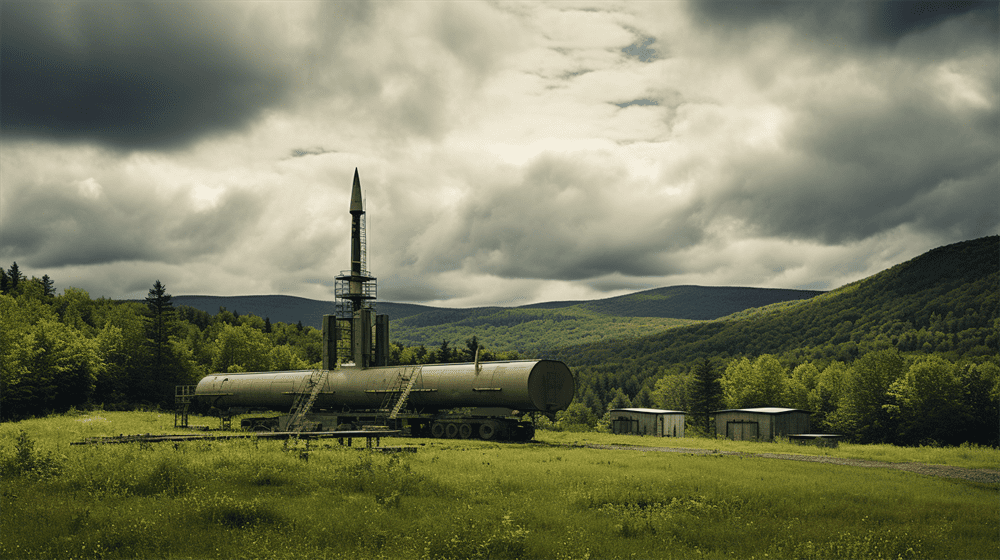A Unique Historical Site in the Champlain Islands
The Alburgh Vermont Missile Silo is a fascinating historical site that played a crucial role during the Cold War. It was one of the 12 missile sites constructed by the military around the Plattsburgh Air Force Base to defend against the Soviet Union. Two of these sites were located in Vermont, with the Alburgh Missile Silo being one of them.
* Please note that the site is not publicly accessible for visits, photos, etc., which is why we have provided AI creative illustrations. Hence, the images do not accurately portray the actual missile site.
Formerly equipped with Atlas F missiles, the Alburgh Vermont Missile Silo was designed to withstand a direct nuclear attack. It stood as a symbol of the nation's preparedness and commitment to protecting its citizens during the tense Cold War era. From 1962 to 1965, these missiles were active and ready for defense. The town of Alburgh is the northernmost location of the Champlain Islands.
However, with advancements in missile technology and changing defense strategies, the Atlas F missiles became obsolete. The Alburgh Vermont Missile Silo eventually fell into disuse and was abandoned. Over time, the silo filled with water, adding an eerie element to its current state.
Nevertheless, there has been a renewed interest in these missile silos, including the Alburgh site. Some missile silos have been sold to private buyers who see the potential for renovation and repurposing them. However, the Alburgh site currently serves as the headquarters for the town's highway department.
Although its active days are long gone, the Alburgh Vermont Missile Silo stands as a testament to the nation's history. It offers a unique glimpse into the military efforts and preparedness during the Cold War, showcasing the determination to protect the country from a potential nuclear apocalypse.
Key Takeaways:
- The Alburgh Vermont Missile Silo played a crucial role in the nation's defense during the Cold War.
- Formerly equipped with Atlas F missiles, the silo was designed to withstand a nuclear attack.
- The missiles were active from 1962 to 1965 before becoming obsolete.
- Today, some missile silos, including the Alburgh site, are being sold to private buyers for renovation purposes.
- The Alburgh Vermont Missile Silo serves as a reminder of the nation's preparedness and commitment to protecting its citizens.
The Cold War Era and Missile Defense
The Cold War era was marked by heightened tensions between the United States and the Soviet Union, leading to the development of missile defense systems like the Alburgh Vermont Missile Silo. As the threat of nuclear war loomed large, both countries sought ways to protect themselves from potential attacks. The Alburgh Vermont Missile Silo, along with 12 other sites around the Plattsburgh Air Force Base, was a crucial part of the United States' defense strategy.
During this period, the military constructed these missile sites to house the powerful Atlas F missiles. These intercontinental ballistic missiles were capable of delivering nuclear warheads to targets thousands of miles away. The Alburgh site was designed to withstand a direct nuclear strike, with reinforced concrete and other defensive measures to ensure its survival.
However, the operational period of the Alburgh Vermont Missile Silo was relatively short-lived. From 1962 to 1965, the missile site stood ready to defend the country against any potential nuclear attack. But with advancing technology and changing strategic priorities, the Atlas F missiles became obsolete, rendering the silo redundant. The site was eventually decommissioned.
Despite its obsolescence, the Alburgh Vermont Missile Silo remains a testament to the nation's preparedness during a tumultuous period in history. Today, while the silo itself is abandoned and flooded, it serves as a reminder of the country's past defense efforts. As renewed interest in missile silos emerges, with some being sold to private buyers for renovation purposes, the Alburgh site currently finds a different purpose as the town's highway department headquarters. It stands as a unique historical site, preserving the memory of the Cold War era and the nation's dedication to national security.
The Construction and Purpose of the Alburgh Vermont Missile Silo

The construction of the Alburgh Vermont Missile Silo was a feat of engineering. These underground facilities were designed to withstand a direct nuclear attack and were built to be self-sustaining, with provisions for long-term occupancy. The missile launch facility consisted of a reinforced underground structure, housing the missile and its launch equipment, along with living quarters and support systems for the crew.
During the operational period from 1962 to 1965, the Alburgh Vermont Missile Silo maintained a vigilant watch for any potential threats. However, advancements in missile technology rendered the Atlas F missiles obsolete, and the silos were decommissioned.
While the Alburgh Vermont Missile Silo is no longer active, it remains an intriguing piece of history. The preserved structures provide a rare glimpse into the military's mindset during a time of heightened tensions. With renewed interest in these unique sites, some missile silos have been sold to private buyers for renovation projects. Although the Alburgh site is not currently available for private ownership or curious visitors, it continues to captivate the imagination and preserves the memory of the nation's commitment to defense during the Cold War.
The Atlas F Missiles and Nuclear Defense
Equipped with Atlas F missiles, the Alburgh Vermont Missile Silo was designed to withstand a direct nuclear attack. These powerful missiles were an integral part of the United States' nuclear defense strategy during the Cold War era. The Atlas F missiles were intercontinental ballistic missiles (ICBMs) capable of delivering nuclear warheads with devastating precision.
With a range of over 5,500 miles, these missiles were a formidable deterrent against potential adversaries, especially the Soviet Union. The Alburgh Vermont Missile Silo, along with other similar sites, represented the nation's commitment to maintaining a strong nuclear defense system. The site was heavily fortified and equipped with advanced security systems to protect these vital military assets.
The Power of the Atlas F Missiles

The Atlas F missiles housed within the Alburgh Vermont Missile Silo were capable of carrying nuclear warheads with a destructive force equivalent to several megatons of TNT. These powerful weapons were designed to strike targets in a matter of minutes, ensuring a swift response in the event of a nuclear threat.
During the operational period from 1962 to 1965, the Atlas F missiles at the Alburgh Vermont Missile Silo represented a significant component of the United States' nuclear deterrence capabilities. However, advancements in missile technology rendered these silos obsolete, and the Alburgh site, like many others, was decommissioned.
Today, the Alburgh Vermont Missile Silo stands as a testament to the nation's history and the once-preparedness for a potential nuclear conflict. While the site may no longer serve its original purpose, it reminds us of the importance of preserving historical landmarks that showcase the efforts made to ensure the nation's security during a tumultuous period in global history.
The Operational Period and Obsolescence
As the Cold War continued and advancements in missile technology were made, the Alburgh Vermont Missile Silo became outdated. Newer missile systems were developed, rendering the Atlas F missiles obsolete. With the changing geopolitical landscape and shifts in defense strategies, these missile sites were no longer deemed necessary.
Today, the Alburgh Vermont Missile Silo stands as a testament to a bygone era. The site, now decommissioned and abandoned, serves as a reminder of the nation's preparedness for a potential nuclear apocalypse. Though no longer operational, the silo still holds historical significance, providing an insight into the military strategies and tensions of the Cold War period.
Alburgh Vermont Missile Silo: Renewed Interest and Potential Renovation
There has been a recent surge of interest in missile silos, including the Alburgh site, with private buyers purchasing them for renovation projects. These once top-secret underground facilities, remnants of the Cold War era, are attracting individuals and organizations eager to preserve and repurpose them.
With their unique architecture and historical significance, decommissioned missile silos offer a fascinating opportunity for creative and adaptive reuse. Buyers have recognized the potential of these underground structures, envisioning them as everything from luxury homes to underground museums and event spaces.
One of the main appeals of purchasing a missile silo for renovation is the sheer amount of space they offer. These structures were designed to house massive missiles, and as a result, they feature large underground chambers and extensive tunnels. This inherent spaciousness allows for endless possibilities when it comes to redesigning and repurposing the space to suit various needs and functions.
However, it's important to note that renovating a missile silo is not without its challenges. These structures were designed with strict security measures and engineering specifications, making the renovation process complex and demanding. From dealing with the underground environment to updating systems and ensuring structural integrity, transforming a missile silo into a habitable or functional space requires careful planning and expertise.
Despite these challenges, the renewed interest in missile silos like the one in Alburgh showcases a growing appreciation for preserving history and repurposing unique architectural structures. By giving these sites a new lease on life, private buyers are not only preserving a significant part of our nation's history but also creating opportunities for future generations to learn about and appreciate the efforts made during the Cold War era.
The Alburgh Vermont Missile Silo Today
Today, the Alburgh Vermont Missile Silo serves as the headquarters for the town's highway department. This unique historical site, once a crucial part of the country's defense during the Cold War, has found a new purpose in serving the local community. While the site is no longer active in its original capacity, it stands as a reminder of a significant era in American history.
Despite the passage of time, the Alburgh Vermont Missile Silo still retains its iconic structure, showcasing the ingenuity and engineering prowess of the past. The abandoned and flooded silo serves as a testament to the preparedness and dedication of the men and women who defended the nation from potential nuclear threats. It stands as a symbol of the nation's resolve during a tumultuous period.
Although the site is currently inaccessible to the public due to safety concerns, there is no denying the renewed interest in these missile silos. Across the country, private buyers have shown a keen interest in acquiring and renovating these historic sites. The Alburgh Vermont Missile Silo, with its intriguing history and unique architecture, holds the potential to become a captivating destination for future generations to explore.
Preserving History and Inspiring Future Generations
The Alburgh Vermont Missile Silo is more than just a relic of the past. Its preservation is crucial in maintaining a connection to our history and the sacrifices made by those who served. By safeguarding this site, we ensure that future generations can learn from the past and gain a deeper understanding of the country's military efforts and the realities of the Cold War era.
- It serves as a reminder of the nation's commitment to protecting its citizens during a time of great uncertainty.
- Its unique architecture and engineering highlight the innovative spirit of the past.
- Exploring the Alburgh Vermont Missile Silo offers a chance to reflect on the advancements made in national defense and the pursuit of peace.
In conclusion, the Alburgh Vermont Missile Silo stands as a testament to the nation's history and the determination to safeguard its citizens. Today, it serves a new purpose as the headquarters for the town's highway department, but its importance goes far beyond that. By preserving and showcasing this remarkable site, we honor the past while inspiring future generations to appreciate the sacrifices made and the strides taken to secure a safer future.
Renewed Interest and Potential Renovation
In recent years, there has been a resurgence of interest in missile silos like the one in Alburgh. Some of these decommissioned silos have been sold to private buyers who envision renovating them into unique living spaces or other innovative uses. The allure of owning a piece of history combined with the potential for a one-of-a-kind underground structure has captured the imagination of many.
FAQ
Q: Can visitors access the Alburgh Vermont Missile Silo?
A: No, the Alburgh Vermont Missile Silo is currently being used as the town's highway department headquarters and is not open to the public for visitation.
Q: Were the Atlas F missiles ever used in a real nuclear attack?
A: No, the Atlas F missiles at the Alburgh Vermont Missile Silo were never used in a real nuclear attack. They were only active from 1962 to 1965 before becoming obsolete.
Q: Are there any plans to renovate the Alburgh Vermont Missile Silo?
A: As of now, there are no plans to renovate the Alburgh Vermont Missile Silo. However, there is renewed interest in missile silos like this one, with some being sold to private buyers for potential renovation.
Q: What is the current state of the Alburgh Vermont Missile Silo?
A: The Alburgh Vermont Missile Silo is currently abandoned and flooded. It serves as the town's highway department headquarters but is no longer operational as a missile silo.
Q: Are there other missile silos similar to the one in Alburgh, Vermont?
A: Yes, there were a total of 12 missile sites constructed around the Plattsburgh Air Force Base, including two in Vermont. These sites were part of the country's defense against the Soviet Union during the Cold War.
Thank you for reading this post, don't forget to subscribe to our email list for the latest news!





